A vulnerable population is a group of individuals who are at increased risk for health problems and health disparities.[1] Health disparities are health differences linked with social, economic, and/or environmental disadvantages. Health disparities adversely affect groups of people who often experience greater obstacles to health based on individual characteristics, such as socioeconomic status, age, gender, culture, religion, mental illness, disability, sexual orientation, or gender identity.[2]
Examples of vulnerable populations are[3],[4]:
- The very young and the very old
- Individuals with chronic illnesses, disabilities, or communication barriers
- Veterans
- Racial and ethnic minorities
- Individuals who identify as lesbian, gay, bisexual, transgender, or queer (LGBTQ)
- Victims of human trafficking or sexual violence
- Individuals who are incarcerated and their family members
- Rural Americans
- Migrant workers
- Individuals with chronic mental health disorders
- Homeless people
Individuals typically have less access and use of health services, resulting in significant health disparities in life expectancy, morbidity, and mortality. They are also more likely to have one or more chronic physical and/or mental health illnesses.[5] Advancing health equity for all members of our society is receiving increased emphasis as a central goal of public health. Health equity is defined by the U.S. Department of Health and Human Services as the “attainment of the highest level of health for all people” and that “achieving health equity requires valuing everyone equally with focused and ongoing societal efforts to address avoidable inequities, historical and contemporary injustices, and the elimination of health and health care disparities.”[6]
Examples of vulnerable populations and associated resources available to promote health equity and reduce health disparities are further described in the following sections.
Age and Developmental Status
Developmental status and age are associated with vulnerability. Children have health and developmental needs that require age-appropriate care. Developmental changes, dependency on others, and different patterns of illness and injury require that attention be paid to the unique needs of children in the health system. The elderly population also has unique health care needs due to increased incidence of illness and disability, as well as the complex interactions of multiple chronic illnesses and multiple medications.[7]
Children and the elderly are also vulnerable to experiencing neglect and abuse. Nurses must be aware of signs of neglect and abuse and are legally mandated to report these signs. Read more about neglect, abuse, and mandatory reporting in the “Trauma, Abuse, and Violence” chapter.
Chronic Illness and Disability
Individuals with chronic illnesses and/or disabilities are more likely than the general population to experience problems in accessing a range of health care services. These vulnerable groups may also experience lack of coordination of care across multiple providers. In addition, individuals with specific chronic illnesses, such as individuals with mental illness or human immunodeficiency virus (HIV), may face social stigma that makes it challenging to seek and/or receive appropriate health care.[8] See Figure 17.1[9] for an image of a disabled individual who is considered a member of a vulnerable population.

In addition to experiencing challenges in accessing appropriate health care, adults with disabilities report experiencing more mental distress than the general population. In 2018 an estimated 17.4 million (32.9%) adults with disabilities experienced frequent mental distress, defined as 14 or more reported mentally unhealthy days in the past 30 days. Frequent mental distress is associated with poor health behaviors, mental health disorders, and limitations in daily life.[10] The National Center on Health, Physical Activity and Disability (NCHPAD) is a public health resource center that focuses on health promotion, wellness, and quality of life for people with disabilities.
The Barrier-Free Health Care Initiative is a national initiative by the American Disability Association and the Offices of the United States Attorneys that supports people with disabilities. It legally enforces appropriate access to health care services, such as effective communication for people who are deaf or have hearing loss, physical access to medical care for people with mobility disabilities, and equal access to treatment for people who have HIV/AIDS. This nationwide initiative sends a collective message that disability discrimination in health care is illegal and unacceptable.
Visit the Barrier-Free Health Care Initiative to learn more.
Visit the National Center on Health, Physical Activity and Disability (NCHPAD) for additional wellness resources.
Veterans
A veteran is someone who has served in the military forces. Veterans have higher risks for mental health disorders, substance abuse, post-traumatic stress disorders, traumatic brain injuries, and suicide compared to their civilian counterparts. Medical records of veterans reveal that one in three clients was diagnosed with at least one mental health disorder.[11] Identifying and treating mental health disorders in veterans have the greatest potential for reducing suicide risk, but the reluctance in this population to seek treatment can make diagnosing and treating mental illness challenging. Nurses must be aware of their clients’ military history, recognize risk factors for common disorders, and advocate for appropriate health care services.[12] See Figure 17.2[13] for an image of a veteran.

Veterans Affairs (VA) provides health care and other benefits to individuals serving on active duty in the United States uniformed services. The Veterans Health Administration is the largest health care network in the United States with 1,255 health care facilities and serves nine million enrolled veterans each year. In addition to health care, benefits may include educational loans, home loans or housing grants, and life insurance. Nurses can refer clients who are veterans to the VA for more information about benefits.
Nurses can also refer veterans and their family members to the National Alliance on Mental Health (NAMI) Homefront course. NAMI Homefront is a class for families, caregivers, and friends of military service members and veterans with mental health conditions. The course is designed specifically to help these individuals understand mental health disorders and improve their ability to support their service member or veteran.
Visit the Veterans Affairs (VA) website for additional information on health care and other benefits for military service members.
Visit the NAMI Homefront course to learn more about mental health conditions and resources available to military service members and their families.
Racial and Ethnic Minorities
Racial and ethnic minority populations in the United States experience significant health disparities.[14] See Figure 17.3[15] for an image of a child from a minority population. The U.S. Department of Health and Human Services Office of Minority Health provides Minority Population Profiles for Black/African Americans, American Indian/Alaska Natives, Asian Americans, Hispanic/Latinos, and Native Hawaiian/Pacific Islanders. Profiles include demographics, English language fluency, education, economics, insurance coverage and health status information, and full census reports. Nurses can access these profiles to view health care statistics regarding these populations and services available in their communities.
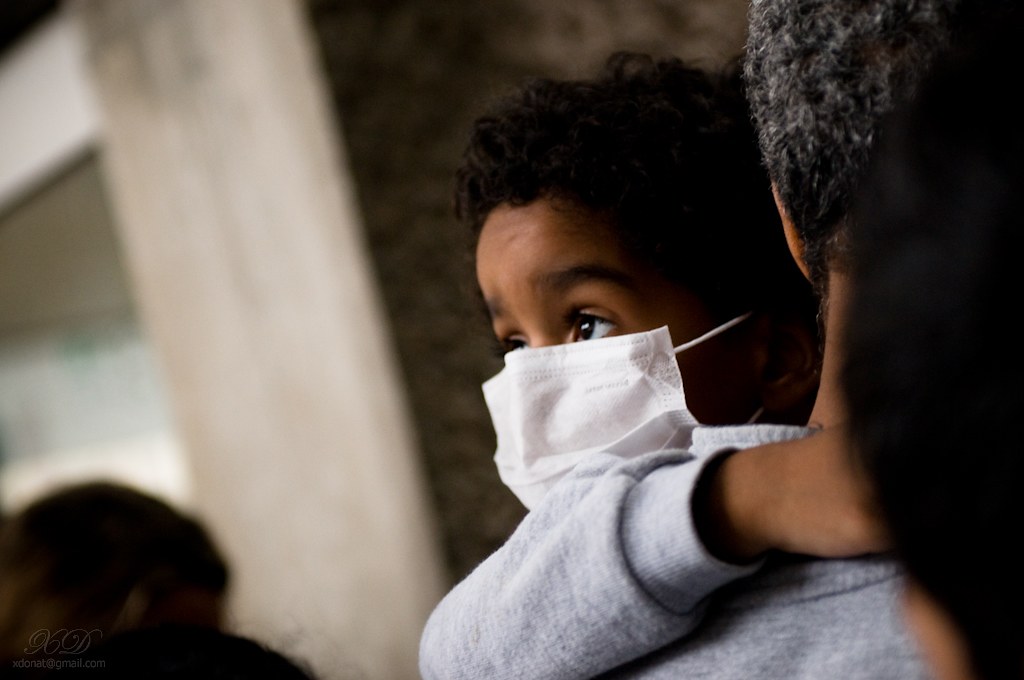
The Office of Minority Health is dedicated to improving the health of racial and ethnic minority populations through the development of health policies and programs that help eliminate health disparities.
Visit the Office of Minority Health to learn more about efforts to improve the health of racial and ethnic minority populations through health policy and program development. Examples of initiatives include the following[16]:
COVID-19 Response
Improving Cultural Competency for Behavioral Health Professionals
Sickle Cell Disease Initiative
LGBTQ Population
The lesbian, gay, bisexual, transgender, and queer or questioning (LGBTQ) population encompasses all races and ethnicities, religions, and social classes. See Figure 17.4[17] for an image of a pride festival by an LGBTQ population. Research suggests that LGBTQ individuals experience health disparities linked to societal stigma, discrimination, and denial of their civil rights.[18] The LGBTQ population experiences high rates of mental health disorders, substance abuse, and suicide, and experiences of violence and victimization are frequent for LGBTQ individuals and can result in long-lasting effects.[19]

Community efforts to improve the health of the LGBTQ population include these initiatives[20]:
- Training health professionals to appropriately inquire and support clients’ sexual orientation and gender identity to promote regular use of health care services
- Training health professionals and students regarding culturally competent care
- Providing supportive social services to reduce suicide and homelessness among youth
- Curbing sexually transmitted infections and human immunodeficiency virus (HIV) transmission
Discover health services by state at CDC’s LGBT Health website.
Human Trafficking Victims
Human trafficking victims are forced to work or provide commercial sex against their will in legal business settings and underground markets.[21] The International Labor Organization estimates there are 40.3 million victims of human trafficking globally. Victims include men, women, adolescents, and children.[22] Experts estimate that 100,000 incidents of sexual exploitation of minors occur each year in the United States.[23] Human trafficking victims have been identified in cities, suburbs, and rural areas in all 50 states and in Washington, D.C. See Figure 17.5[24] regarding human trafficking statistics reported by state in 2020.
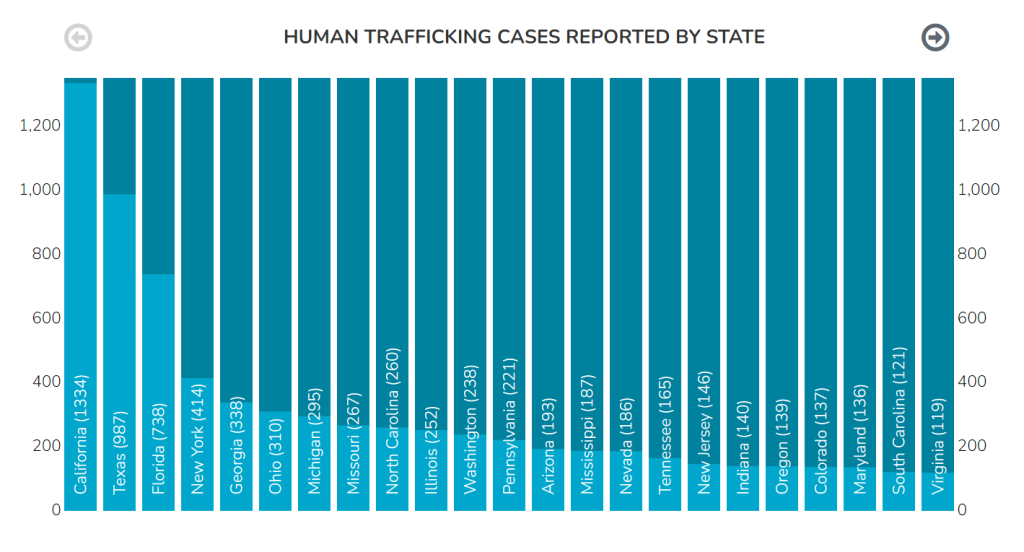
Widespread lack of awareness and understanding of trafficking leads to low levels of victim identification. Individuals at risk include runaway and homeless youth, foreign nationals, and individuals with prior history of experiencing violence or abuse. A study in Chicago found that 56 percent of female prostitutes were initially runaway youth, and similar numbers have been identified for male populations.[25]
Foreign nationals who are trafficked within the United States face unique challenges. Recruiters located in home countries frequently require such large recruitment and travel fees that victims become highly indebted to the recruiters and traffickers.
Individuals who have experienced violence and trauma in the past are more vulnerable to future exploitation because the psychological effect of trauma is often long-lasting and challenging to overcome. Victims of domestic violence, sexual assault, war, or social discrimination may be targeted by traffickers who recognize the vulnerabilities left by these prior abuses.[26]
These are some of the services victims of trafficking may need[27]:
- Emergency Services
- Crisis Intervention and Counseling
- Emergency Shelter and Referrals
- Urgent Medical Care
- Safety Planning
- Food and Clothing
For more information about the services available to victims of human trafficking, visit the National Human Trafficking Hotline Referral Directory.
See an example of a nurse providing care for victims of human trafficking in their community in the “Spotlight Application” section.
Incarcerated Individuals and Their Families
At the end of 2019, there were over 2 million people in U.S. prisons and jails with a nationwide incarceration rate of 810 inmates for every 100,000 adults. Higher rates of incarceration are seen among racial/ethnic minorities and people with lower levels of education. The United States incarcerates a larger share of its population than any other country in the world.[28] See Figure 17.6[29] for an illustration comparing worldwide incarceration rates.[30]
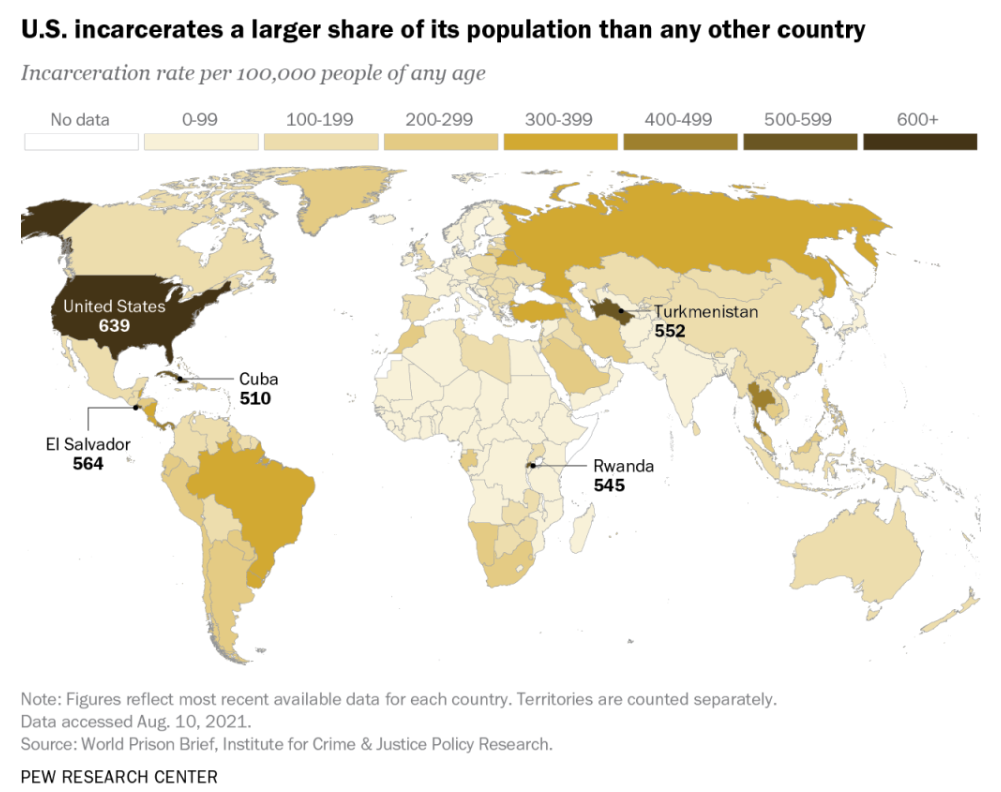
Many individuals who are incarcerated have chronic health conditions, including mental illness and addiction. Over half of all inmates have a mental health disorder, and female inmates have higher rates of post-traumatic stress disorder (PTSD) than the general population. In fact, some experts believe that escalation of U.S. incarceration rates since the 1970s is associated with inadequate community-based health care for mental illness and addiction; left untreated, both conditions can lead to behaviors that result in incarceration.[31]
Health care is a constitutional right for prisoners. The 1976 Supreme Court decision in Estelle v. Gamble found that “deliberate indifference to serious medical needs of prisoners” constitutes a violation of the Eighth Amendment prohibition of cruel and unusual punishment. Nurses working in correctional facilities have a legal and ethical obligation to respond to requests for care. If an inmate’s safety complaints are ignored, safety risks are not removed, or there is failure to provide proper medical attention, it is considered “deliberate indifference.” Correctional nurses have a duty to evaluate prisoners’ health needs and determine the level of care required. For example, the nurse determines if the prisoner should be moved to the medical unit or transferred to a health facility that can provide the level of care needed. In addition, all pertinent information of health encounters with prisoners must be thoroughly documented and include assessment finding, health needs, interventions taken, patient education, and evaluation of patient outcomes.[32]
While the Supreme Court decision mandates health care provision for incarcerated populations in prisons and jails, it does not extend to those under supervision within the criminal justice system (e.g., on parole, probation, or home confinement).[33] However, the Patient Protection and Affordable Care Act (ACA) helps to ensure continuity of medical coverage and care when prisoners are released into the community.[34]
While mortality rates within prisons and jails are comparable to those of the general population, releasees are nearly 13 times more likely to die in the two weeks following their release than the general population. The most common cause of death is overdose. Interventions that follow in-prison drug treatment programs with post-release treatment have been shown to reduce drug use and associated recidivism (i.e., return to prison). There have also been efforts to improve the outcomes of prisoner reentry to society through assistance with employment, housing, and other transitional needs that ultimately affect health.[35],[36]
The National Alliance on Mental Health (NAMI) provides several Re-Entry Planning resources.
Incarceration has a public health impact on prisoners’ family members and their communities while they are incarcerated, as well as after their release. Community health is affected by incarceration due to economic impacts (i.e., consequences on families’ well-being when income earners are removed) and long-term impacts on children’s health and mental health (also referred to as adverse childhood events). For example, children of incarcerated parents are more likely to live in poverty, as well as have higher rates of learning disabilities, developmental delays, speech/language problems, attention disorders, aggressive behaviors, and drug and alcohol use. Additionally, children of incarcerated parents are up to five times more likely to enter the criminal justice system than children of nonincarcerated parents.[37],[38]
Family-centered services for incarcerated parents and their children focus on parenting programs, family strengthening activities, nurturing of family relationships, and community support for families during incarceration and following release.
Read more about family-centered services at U.S. Department of Health Services Child Welfare Information Gateway.
Read additional guidance and resources at CDC Correctional Health.
Rural Americans
Rural Americans are a population group that experiences significant health disparities. Rural risk factors for health disparities include geographic isolation, lower socioeconomic status, higher rates of health risk behaviors, limited access to health care specialists, and limited job opportunities. This inequality is intensified because rural residents are less likely to have employer-provided health insurance or Medicaid coverage.[39],[40] See Figure 17.7[41] for an image of a small town in rural America.
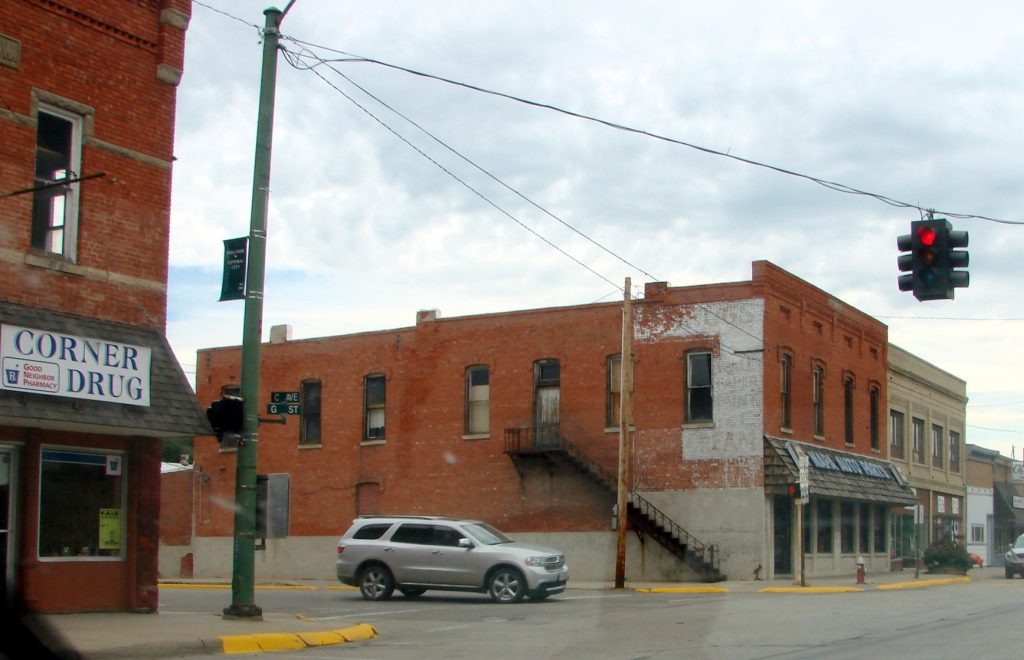
For an in-depth look at rural health disparities, the Rural Health Information Hub Rural Health Series serves as a resource to examine rural mortality and preventable deaths, health-related behaviors, chronic disease, mental health services, and other related topics. The Federal Office of Rural Health Policy provides additional information regarding rural health policy, community health programs, and telehealth programs to increase access to health care for underserved people in rural communities. Two initiatives to improve rural health are the National Health Service Corps (NHSC) loan repayment program and telehealth.[42]
NHSC builds healthy communities by supporting health care professionals dedicated to working in areas of the United States with limited access to care. NHSC offers educational loan repayment programs to health professionals who commit to working in underserved areas for specific lengths of time.[43] See an infographic about NHSC in Figure 17.8.[44]
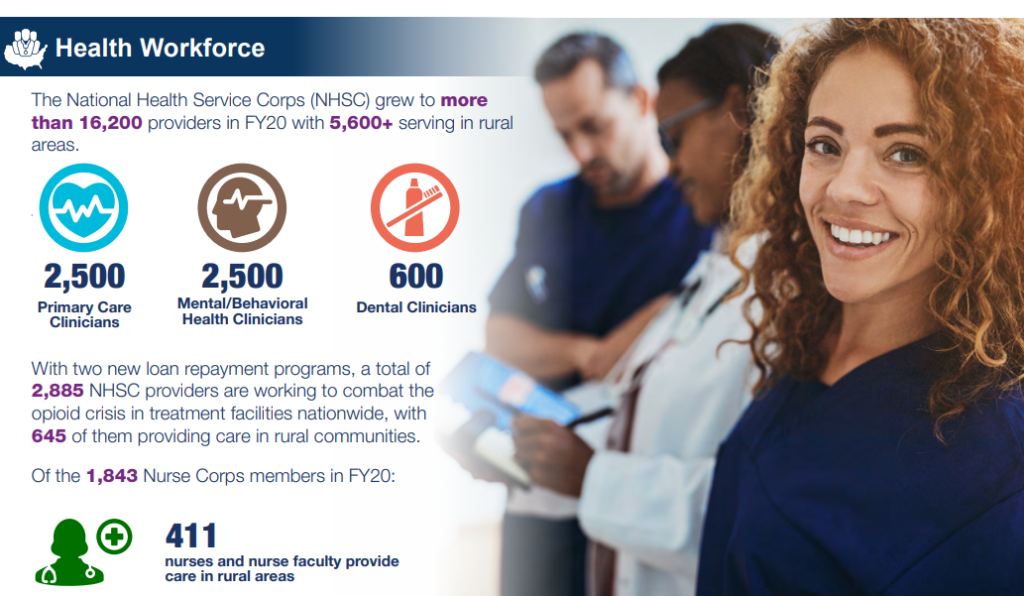
Telehealth is a recent initiative to improve health care access to underserved communities. Telehealth is the use of digital technologies to deliver medical care, health education, and public health services by connecting multiple users in separate locations. See Figure 17.9[45] for an image of telehealth. Telehealth can improve health outcomes and access to care by delivering health services in underserved areas and remove barriers of time, distance, and provider scarcities.[46] Nurses support clients using telehealth and provide patient education.
However, telehealth can risk widening disparities for some socioeconomic groups with limited access to the resource necessary for effective telemedicine. Nurses can help ensure that health care systems tailor the use of technology to meet the needs of underserved populations.[47]
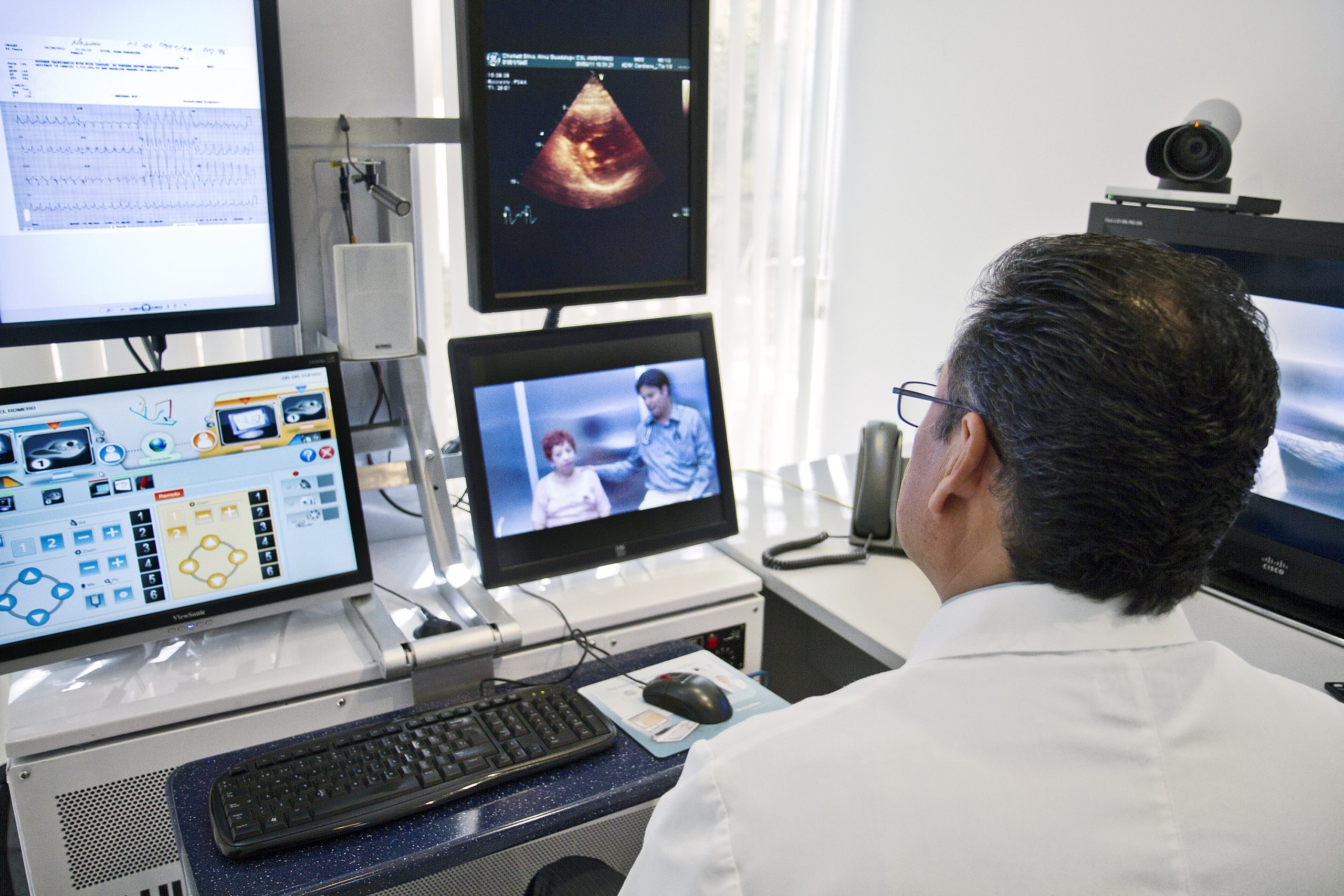
Visit the Rural Health Information Hub Rural Health Series to examine rural mortality and preventable deaths, health-related behaviors, chronic disease, mental health services, and other related topics.
Learn more about the NHSC and how it supports health care professionals to provide care in areas with limited access to health services.
Migrant Workers
A migrant worker is a person who moves within their home country or outside of it to pursue work. Migrant workers usually do not intend to stay permanently in the country or region in which they work. See Figure 17.10[48] for an image of migrant workers harvesting cabbage.
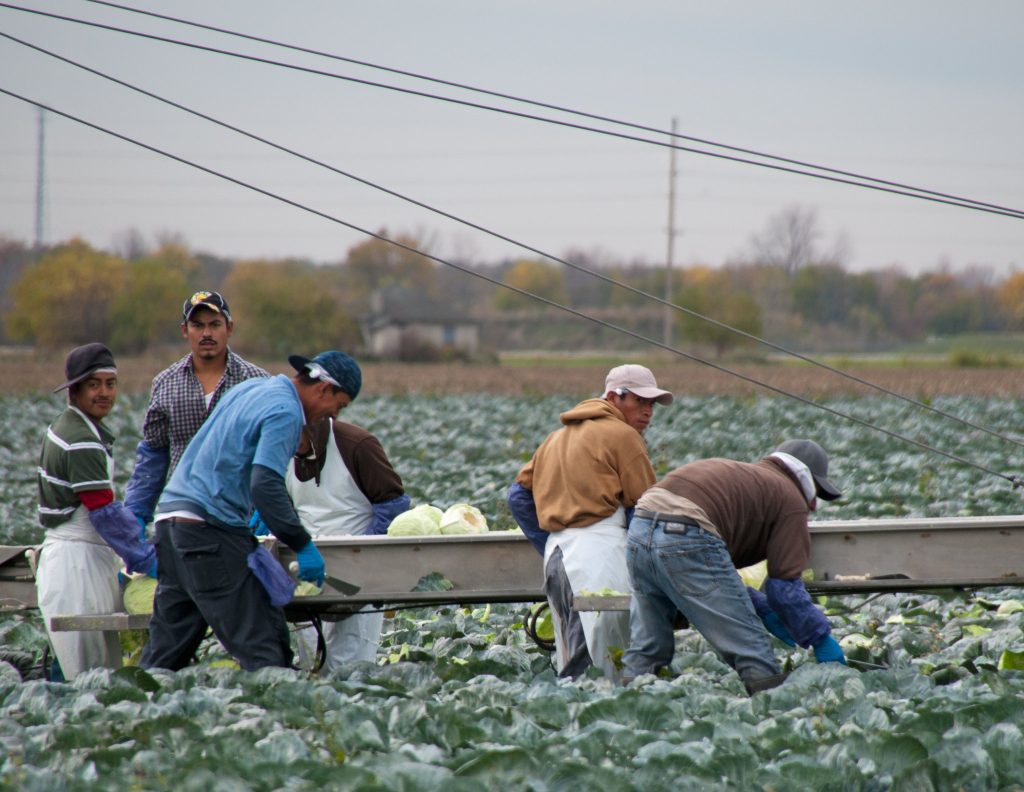
Migratory and seasonal agricultural workers (MASW) and their families face unique health challenges that can result in significant health disparities. Challenges can include the following[49]:
- Hazardous work environments
- Poverty
- Insufficient support systems
- Inadequate or unsafe housing
- Limited availability of clean water and septic systems
- Inadequate health care access and lack of continuity of care
- Lack of health insurance
- Cultural and language barriers
- Fear of using health care due to immigration status
- Lack of transportation
MSAW populations experience serious health problems including diabetes, malnutrition, depression, substance use, infectious diseases, pesticide poisoning, and injuries from work-related machinery. These critical health issues are exacerbated by the migratory culture of this population group that increases isolation and makes it difficult to maintain treatment regimens and track health records.[50]
Successful strategies to support health services for migrant workers are as follows[51]:
- Culturally sensitive health education and outreach
- Educational materials at the appropriate literacy level
- Portable medical records and case management
- Mobile medical units
- Transportation services
- Translation services
Nurses can refer uninsured migrant farmworkers to Migrant Health Centers or other federally qualified health centers that are open to everyone. Individuals who do not have health insurance can pay for services based on a sliding-fee scale.
Read more about promoting migrant worker health at the Rural Migrant Health Information Hub.
Individuals with Mental Health Disorders
One in five American adults experiences some form of mental illness. Despite a recent focus on mental health in America, there are still many harmful attitudes and misunderstandings surrounding mental illness that can cause people to ignore their mental health and make it harder to reach out for help.[52]
Many individuals with mental health disorders go undiagnosed. Nurses must be aware of these common signs of mental health disorders[53]:
- Excessive worrying or fear
- Excessively sad feelings
- Confused thinking or problems concentrating and learning
- Extreme mood changes, including uncontrollable “highs” or feelings of euphoria
- Prolonged or strong feelings of irritability or anger
- Avoidance of friends and social activities
- Difficulties understanding or relating to other people
- Changes in sleeping habits or feeling tired and low energy
- Changes in eating habits, such as increased hunger or lack of appetite
- Changes in sex drive
- Disturbances in perceiving reality (e.g., delusions and hallucinations)
- Inability to perceive changes in one’s own feelings, behavior, or personality (i.e., lack of insight)
- Overuse of substances like alcohol or drugs
- Multiple physical ailments without obvious causes (such as headaches, stomachaches, or vague and ongoing “aches and pains”)
- Thoughts of suicide
- Inability to carry out daily activities or handle daily problems and stress
- An intense fear of weight gain or overly concerned with appearance
Mental health conditions are also present in children. Because children are still learning how to identify and talk about thoughts and emotions, their most obvious symptoms are behavioral. Behavioral symptoms in children can include the following[54]:
- Changes in school performance
- Excessive worry or anxiety
- Hyperactive behavior
- Frequent nightmares
- Frequent disobedience or aggression
- Frequent temper tantrums
Nurses should recognize signs and symptoms of potentially undiagnosed mental health problems in all care settings and make appropriate referrals to mental health professionals and support organizations.
National Alliance on Mental Illness (NAMI) provides advocacy, education, support, and public awareness so that all individuals and families affected by mental illness can build better lives. NAMI’s strategic goals are for people to get help early, get the best possible care, and be diverted from justice system involvement.[55]
NAMI offers these programs that promote improved care for individuals with mental illness and their loved ones:
- Your Journey With Mental Illness is a web page with several resources such as understanding your diagnosis, finding a health professional, understanding insurance, handling a crisis, and navigating finances and work.
- NAMI Basics is an educational program for parents, family members, and caregivers who provide care for youth (ages 22 and younger) who are experiencing mental health symptoms. The program covers these topics:
- Impact mental health conditions can have on the entire family
- Different types of mental health care professionals and available treatment options and therapies
- Overview of the public mental health care, school, and juvenile justice systems and resources to help navigate these systems
- Child rights advocacy at school and in health care settings
- Preparation and response to crisis situations (self-harm, suicide attempts, etc.)
- Importance of self-care
- NAMI Provider introduces mental health professionals to the unique perspectives of people with mental health conditions and their families. It promotes empathy for their daily challenges and the importance of including them in all aspects of the treatment process.
- NAMI In Our Own Voice is a program to promote a change in attitudes, assumptions, and ideas about people with mental health conditions. Presentations provide a personal perspective of mental health conditions, as leaders with lived experience talk openly about what it’s like to have a mental health condition.
Homeless People
Homelessness can significantly affect an individual’s health in three ways: health problems caused by homelessness, health problems that cause homelessness, and health conditions that are difficult to treat because of homelessness. As a result, the average age of death among homeless people is the mid-50s.[56]
Homeless people face multiple barriers to health care, including transportation, fragmentation of health care services, difficulty scheduling and keeping appointments, stigma of homelessness, lack of trust, social isolation, and significant basic physiological needs. Homeless people frequently have multiple needs resulting from exposure to violence or the elements, food insecurity, and untreated or undertreated physical and mental illnesses, resulting in frequent emergency department visits and hospitalizations.[57]
Effective health care for the homeless population addresses social determinants of health, such as housing, income, food, and social supports. The Medical Home Model developed by the Veterans Health Administration is an example of a proactive, primary care-based, interdisciplinary team model based on patient-centered, holistic care, and active communication and coordination among providers. This model is considered effective for patients with complex health care needs. See Figure 17.11[58] for an illustration of the Medical Home Model. As homeless veterans stabilize clinically and socially, as evidenced by their moving into permanent housing and demonstrating appropriate self-care and health-seeking behaviors, they are transitioned to traditional care settings to continue their care.[59]
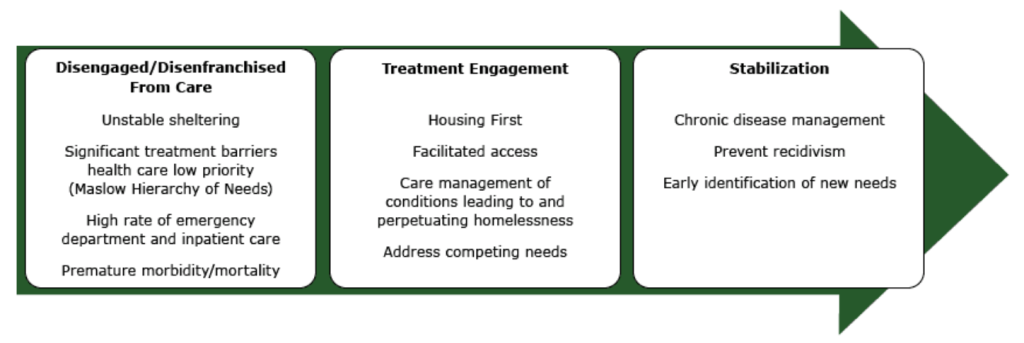
Core elements of the Medical Home Model distinguish it from traditional primary care with the following characteristics[60]:
- Low-threshold access to care
- Open access with walk-in capacity and flexible scheduling (i.e., patients do not need an appointment to be seen by their care team)
- Clinical outreach to homeless people on streets, in shelters, and in community locations such as soup kitchens
- Integrated services
- Mental health services and primary care services are located close to each other, and providers from both services are involved in patients’ health care plan
- Sustenance needs (e.g., food or food vouchers, hygiene kits, clothes, bus passes, other transportation assistance) are available at the same location
- Intensive health care management integrated with community agencies with an emphasis on ongoing, continuous care
- Ongoing staff training focused on development of homeless care skills
Research indicated the Medical Home Model reduced emergency department visits and hospitalizations of the homeless population by integrating supports that addressed social determinants of health into a clinical care model.[61]
- AJMC. (2006, November 1). Vulnerable populations: Who are they? AJMC, 12(1). https://www.ajmc.com/view/nov06-2390ps348-s352 ↵
- HealthyPeople.gov. (2022, February 6). Disparities. Office of Disease Prevention and Health Promotion, U.S. Department of Health and Human Services. https://www.healthypeople.gov/2020/about/foundation-health-measures/Disparities ↵
- Joszt, L. (2018, July 20). 5 vulnerable populations in healthcare. The American Journal of Managed Care. https://www.ajmc.com/view/5-vulnerable-populations-in-healthcare ↵
- AJMC. (2006, November 1). Vulnerable populations: Who are they? AJMC, 12(1). https://www.ajmc.com/view/nov06-2390ps348-s352 ↵
- AJMC. (2006, November 1). Vulnerable populations: Who are they? AJMC, 12(1). https://www.ajmc.com/view/nov06-2390ps348-s352 ↵
- Liburd, L. C., Hall, J. E., Mpofu, J. J., Williams, S. M., Bouye, K., & Penman-Aguilar, A. (2020). Addressing health equity in public health practice: Frameworks, promising strategies, and measurement considerations. Annual Review of Public Health, 41(1), 417-432. https://www.annualreviews.org/doi/10.1146/annurev-publhealth-040119-094119 ↵
- Advisory Commision on Consumer Protection and Quality in the Health Care Industry. (n.d.). Chapter eight: Focusing on vulnerable populations. University of North Texas Libraries and U.S. Government Printing Office. https://govinfo.library.unt.edu/hcquality/meetings/mar12/papch08.htm ↵
- Advisory Commision on Consumer Protection and Quality in the Health Care Industry. (n.d.). Chapter eight: Focusing on vulnerable populations. University of North Texas Libraries and U.S. Government Printing Office. https://govinfo.library.unt.edu/hcquality/meetings/mar12/papch08.htm ↵
- “COVID-19_vaccination_center,_fair_grounds_Cologne,_1st_vaccination-8070.jpg” by Raimond Spekking is licensed under CC BY-SA 4.0 ↵
- Centers for Disease Control and Prevention. (2020, November 30). The mental health of people with disabilities. https://www.cdc.gov/ncbddd/disabilityandhealth/features/mental-health-for-all.html ↵
- Olenick, M., Flowers, M., & Diaz, V. J. (2015). US veterans and their unique issues: Enhancing health care professional awareness. Advances in Medical Education and Practice, 6, 635–639. https://doi.org/10.2147/AMEP.S89479 ↵
- Olenick, M., Flowers, M., & Diaz, V. J. (2015). US veterans and their unique issues: Enhancing health care professional awareness. Advances in Medical Education and Practice, 6, 635–639. https://doi.org/10.2147/AMEP.S89479 ↵
- “DF-SD-03-05175” by Scott H. Spitzer, Civilian, USAF is in the Public Domain. ↵
- Olenick, M., Flowers, M., & Diaz, V. J. (2015). US veterans and their unique issues: Enhancing health care professional awareness. Advances in Medical Education and Practice, 6, 635–639. https://doi.org/10.2147/AMEP.S89479 ↵
- “3678466365_da63d01385_b” by Xavier Donat is licensed under CC BY-NC-ND 2.0 ↵
- Olenick, M., Flowers, M., & Diaz, V. J. (2015). US veterans and their unique issues: Enhancing health care professional awareness. Advances in Medical Education and Practice, 6, 635–639. https://doi.org/10.2147/AMEP.S89479 ↵
- “Pride_Festival_2013_On_The_Streets_Of_Dublin_(LGBTQ)_(9183775778).jpg” by infomatique is licensed under CC BY-SA 2.0 ↵
- HealthyPeople.gov. (2022, February 6). Lesbian, gay, bisexual, and transgender health. Office of Disease Prevention and Health Promotion, U.S. Department of Health and Human Services. https://www.healthypeople.gov/2020/topics-objectives/topic/lesbian-gay-bisexual-and-transgender-health ↵
- HealthyPeople.gov. (2022, February 6). Lesbian, gay, bisexual, and transgender health. Office of Disease Prevention and Health Promotion, U.S. Department of Health and Human Services. https://www.healthypeople.gov/2020/topics-objectives/topic/lesbian-gay-bisexual-and-transgender-health ↵
- HealthyPeople.gov. (2022, February 6). Lesbian, gay, bisexual, and transgender health. Office of Disease Prevention and Health Promotion, U.S. Department of Health and Human Services. https://www.healthypeople.gov/2020/topics-objectives/topic/lesbian-gay-bisexual-and-transgender-health ↵
- National Human Trafficking Hotline. (n.d.). The victims. https://humantraffickinghotline.org/what-human-trafficking/human-trafficking/victims ↵
- National Human Trafficking Hotline. (n.d.). The victims. https://humantraffickinghotline.org/what-human-trafficking/human-trafficking/victims ↵
- Office of the Attorney General for the District of Columbia. (n.d.). Human trafficking initiatives. https://oag.dc.gov/public-safety/human-trafficking-initiatives ↵
- This image is derived from Human Trafficking Hotline data and is in the Public Domain. Access for free at https://humantraffickinghotline.org/states ↵
- National Human Trafficking Hotline. (n.d.). The victims. https://humantraffickinghotline.org/what-human-trafficking/human-trafficking/victims ↵
- National Human Trafficking Hotline. (n.d.). The victims. https://humantraffickinghotline.org/what-human-trafficking/human-trafficking/victims ↵
- National Human Trafficking Hotline. (n.d.). The victims. https://humantraffickinghotline.org/what-human-trafficking/human-trafficking/victims ↵
- Gramlich, J. (2021, August 16). America’s incarceration rate falls to lowest level since 1995. Pew Research Center. https://pewrsr.ch/2rfSmVL ↵
- “U.S. incarcerates a larger share of its population than any other country” by Pew Research Center, Washington, D.C. (August 13, 2021). Used under Fair Use. Access for free at https://www.pewresearch.org/fact-tank/2021/08/16/americas-incarceration-rate-lowest-since-1995/ft_21-08-12_incarceration_2/ ↵
- Rich, J. D., & The Center for Prisoner Health and Human Rights, Miriam Hospital. Incarceration and health. [Working paper]. National Academies. https://sites.nationalacademies.org/cs/groups/dbassesite/documents/webpage/dbasse_083371.pdf ↵
- Rich, J. D., & The Center for Prisoner Health and Human Rights, Miriam Hospital. Incarceration and health. [Working paper]. National Academies. https://sites.nationalacademies.org/cs/groups/dbassesite/documents/webpage/dbasse_083371.pdf ↵
- National Commission on Correctional Health Care. (n.d.). Legal issues. https://www.ncchc.org/legal-issues ↵
- Gramlich, J. (2021, August 16). America’s incarceration rate falls to lowest level since 1995. Pew Research Center. https://pewrsr.ch/2rfSmVL ↵
- Gramlich, J. (2021, August 16). America’s incarceration rate falls to lowest level since 1995. Pew Research Center. https://pewrsr.ch/2rfSmVL ↵
- Rich, J. D., & The Center for Prisoner Health and Human Rights, Miriam Hospital. Incarceration and health. [Working paper]. National Academies. https://sites.nationalacademies.org/cs/groups/dbassesite/documents/webpage/dbasse_083371.pdf ↵
- Massoglia, M., & Pridemore, W. A. (2015). Incarceration and health. Annual Review of Sociology, 41, 291–310. https://doi.org/10.1146/annurev-soc-073014-112326 ↵
- HealthyPeople.gov. (2022, February 6). Incarceration. Office of Disease Prevention and Health Promotion, U.S. Department of Health and Human Services. https://www.healthypeople.gov/2020/topics-objectives/topic/social-determinants-health/interventions-resources/incarceration ↵
- Massoglia, M., & Pridemore, W. A. (2015). Incarceration and health. Annual Review of Sociology, 41, 291–310. https://doi.org/10.1146/annurev-soc-073014-112326 ↵
- Rural Health Information Hub. (2019, April 22). Rural health disparities. https://www.ruralhealthinfo.org/topics/rural-health-disparities ↵
- United States Department of Agriculture. (2018). Rural America at a glance 2018 edition. Economic Information Bulletin, 200. https://www.ers.usda.gov/webdocs/publications/90556/eib-200.pdf?v=3360.9 ↵
- “One_Light_Town"_Small_Town,_Nebraska_7-25-13a_(10784126756).jpg” by inkknife_2000 (7.5 million views +) is licensed under CC BY-SA 2.0 ↵
- Health Resources & Services Administration. (n.d.). Federal office of rural health policy. https://www.hrsa.gov/rural-health/index.html ↵
- National Health Service Corps. Health Resources & Services Administration. https://nhsc.hrsa.gov ↵
- This image is derived from HRSA Programs Serve Rural Communities by Health Resources & Services Administration and is in the Public Domain. ↵
- “Telemedicine_Consult.jpg” by Intel Free Press is licensed under CC BY-SA 2.0 ↵
- Telligen & Great Plains Telehealth Resource & Assistance Center. (2014). Telehealth: Start-up and resource guide. https://www.healthit.gov/sites/default/files/telehealthguide_final_0.pdf ↵
- Ortega, G., Rodriguez, J. A., Maurer, L. R., Witt, E. E., Perez, N., Reich, A., & Bates, D. W. (2020). Telemedicine, COVID-19, and disparities: Policy implications. Health Policy and Technology, 9(3), 368–371. https://doi.org/10.1016/j.hlpt.2020.08.001 ↵
- “5123728839_1b7ce92b5c_k” by Bob Jagendorf is licensed under CC BY-NC 2.0 ↵
- Rural Health Information Hub. (2021, July 1). Rural migrant health. https://www.ruralhealthinfo.org/topics/migrant-health ↵
- Rural Health Information Hub. (2021, July 1). Rural migrant health. https://www.ruralhealthinfo.org/topics/migrant-health ↵
- Rural Health Information Hub. (2021, July 1). Rural migrant health. https://www.ruralhealthinfo.org/topics/migrant-health ↵
- Centers for Disease Control and Prevention. (2021, July 20). Mental health. https://www.cdc.gov/mentalhealth/index.htm ↵
- Centers for Disease Control and Prevention. (2021, July 20). Mental health. https://www.cdc.gov/mentalhealth/index.htm ↵
- National Alliance on Mental Illness. (n.d.). Warning signs and symptoms. https://nami.org/About-Mental-Illness/Warning-Signs-and-Symptoms ↵
- National Alliance on Mental Health. (n.d.). 2020-2025 strategic plan. https://nami.org/NAMInet/Board-of-Directors/Governance-Documents/NAMIStrategicPlan2020 ↵
- O’Toole, T. P., Johnson, E. E., Aiello, R., Kane, V., & Pape, L. (2016). Tailoring care to vulnerable populations by incorporating social determinants of health: The veterans health administration’s “homeless patient aligned care team” program. Preventing Chronic Disease, 13:150567. http://dx.doi.org/10.5888/pcd13.150567 ↵
- O’Toole, T. P., Johnson, E. E., Aiello, R., Kane, V., & Pape, L. (2016). Tailoring care to vulnerable populations by incorporating social determinants of health: The veterans health administration’s “homeless patient aligned care team” program. Preventing Chronic Disease, 13:150567. http://dx.doi.org/10.5888/pcd13.150567 ↵
- This image is derived from O’Toole TP, Johnson EE, Aiello R, Kane V, Pape L. (2016). Tailoring care to vulnerable populations by incorporating social determinants of health: The veterans health administration’s “homeless patient aligned care team” program. Preventing Chronic Disease 13:150567. http://dx.doi.org/10.5888/pcd13.150567 ↵
- O’Toole, T. P., Johnson, E. E., Aiello, R., Kane, V., & Pape, L. (2016). Tailoring care to vulnerable populations by incorporating social determinants of health: The veterans health administration’s “homeless patient aligned care team” program. Preventing Chronic Disease, 13:150567. http://dx.doi.org/10.5888/pcd13.150567 ↵
- O’Toole, T. P., Johnson, E. E., Aiello, R., Kane, V., & Pape, L. (2016). Tailoring care to vulnerable populations by incorporating social determinants of health: The veterans health administration’s “homeless patient aligned care team” program. Preventing Chronic Disease, 13:150567. http://dx.doi.org/10.5888/pcd13.150567 ↵
- O’Toole, T. P., Johnson, E. E., Aiello, R., Kane, V., & Pape, L. (2016). Tailoring care to vulnerable populations by incorporating social determinants of health: The veterans health administration’s “homeless patient aligned care team” program. Preventing Chronic Disease, 13:150567. http://dx.doi.org/10.5888/pcd13.150567 ↵
A group of individuals who are at increased risk for health problems and health disparities.
Health differences that are linked with social, economic, and/or environmental disadvantages.
Everyone has a fair and just opportunity to be as healthy as possible.
Individuals who are forced to work or provide commercial sex against their will in legal business settings and underground markets.
The use of digital technologies to deliver medical care, health education, and public health services by connecting multiple users in separate locations.
A person who moves within their home country or outside of it to pursue work.

